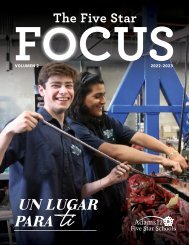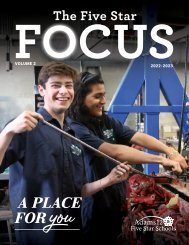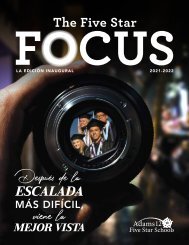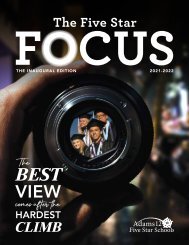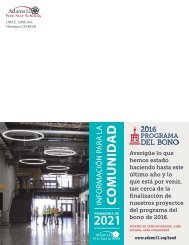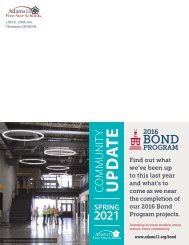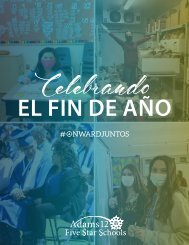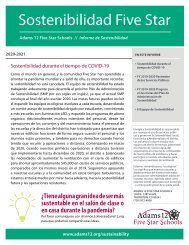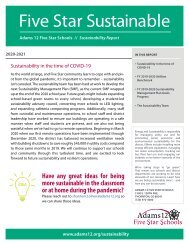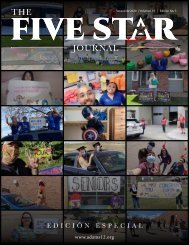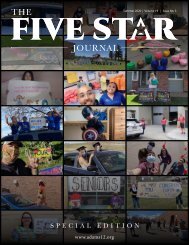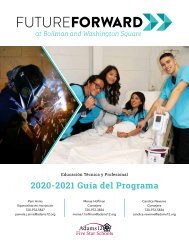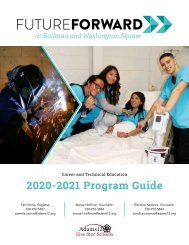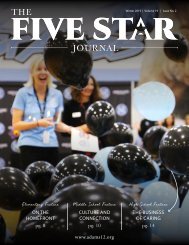2019 Fall Five Star Sustainable Report
- No tags were found...
Create successful ePaper yourself
Turn your PDF publications into a flip-book with our unique Google optimized e-Paper software.
<strong>Five</strong> <strong>Star</strong> <strong>Sustainable</strong><br />
Adams 12 <strong>Five</strong> <strong>Star</strong> Schools // Sustainability <strong>Report</strong><br />
<strong>Fall</strong> <strong>2019</strong><br />
IN THIS REPORT<br />
Sustainability 2.0 – Developing the Next District SMP<br />
The Sustainability Management Plan (SMP) for the district is a compass<br />
directing sustainability and environmental stewardship efforts for district<br />
operations and the communities we serve. As the <strong>2019</strong>-2020 school year<br />
wraps up in June 2020, so does the current SMP. In order to continue district<br />
stewardship to the local, regional and global community, a team of district<br />
personnel have been selected to participate in a Continuous Improvement<br />
project to develop the future SMP framework. Continuous Improvement<br />
is an ongoing effort to improve products, services or processes through<br />
incremental adjustments. Since the current SMP was the first effort of the<br />
district to develop a sustainability compass, the Safe & <strong>Sustainable</strong> Environments<br />
department plans to expand on these efforts. A more comprehensive<br />
and targeted approach will be developed to enhance the triple bottom line<br />
for the district to reduce the environmental impact of district operations,<br />
minimize certain economic needs and provide everyone the opportunity to<br />
do their part.<br />
Once the Continuous Improvement process wraps up, there will be targeted<br />
working sessions with individuals involved in specific focus areas where<br />
goals and strategies need to be developed. There will also be opportunity<br />
to vote and have input on these goals and strategies, without needing to<br />
commit time to their development. If you would be interested in participating<br />
in these targeted groups on topics such as energy, water, waste, student<br />
engagement/education, or would like to be invited to vote on goals and<br />
strategies, please email shannon.t.oliver@adams12.org.<br />
• Sustainability 2.0 – Developing<br />
the Next District SMP<br />
• FY 2018-<strong>2019</strong> Utilities<br />
Benchmark<br />
• FY 2018-<strong>2019</strong> Sustainability<br />
Management Plan Goals Progress<br />
• A Contract for Efficiency<br />
• The Sustainability Team<br />
Energy and Sustainability is responsible<br />
for managing utility use and for<br />
promoting social, economic and<br />
environmental sustainability for the<br />
district. Efforts include installing more<br />
energy efficient equipment, managing<br />
our water consumption, tracking our<br />
bus fleet fuel use and engaging our<br />
students to be better stewards of the<br />
environment.<br />
We’re taking steps to “go green.”<br />
That means our schools and district<br />
departments are working to be wise<br />
stewards of our resources. Learn how<br />
we are being sustainably smart – and<br />
how you can do your part.<br />
The Triple Bottom Line framework is the<br />
basis for many sustainability programs,<br />
covering the needs and resources of an<br />
organization.<br />
ECONOMICS<br />
EVERYONE<br />
ENVIRONMENT<br />
ADAMS 12 FIVE STAR SCHOOLS<br />
1500 E. 128TH AVE,<br />
THORNTON, CO 80241<br />
(720) 972-4000<br />
www.adams12.org/sustainability
Fiscal Year 2018-<strong>2019</strong> Utilities & Sustainability Benchmark<br />
The process of benchmarking involves establishing a baseline for something you are interested in<br />
tracking over time and then comparing recent performance to that historic baseline. For the utilities<br />
and sustainability metrics established by the district, a three-year baseline was set for Fiscal Years (FY)<br />
2014-2016. We are then able to compare our performance for each following fiscal year to that baseline<br />
period. A few exceptions to this exist:<br />
- Total water use is compared on a calendar year basis, due to the watering season falling within<br />
fiscal years during the months of May-September. So while the baseline is still the three-year<br />
average, the current benchmark is for the 2018 calendar year.<br />
- No historic data was available for student engagement or waste diversion rate during the threeyear<br />
baseline period, so those baselines are a one-year period of FY 2016-2017. The current<br />
benchmark is the same as the other metrics, FY 2018-<strong>2019</strong>.<br />
Below is the fiscal year 2018-<strong>2019</strong> benchmark data (2018 for total water use) on how the district<br />
performed, as well as the utilities cost benchmark for the same periods.<br />
FY 2018-<strong>2019</strong> UTILITIES PERFORMANCE BENCHMARK<br />
Parameter Period Performance % Change<br />
Electricity Use 3-Year Baseline 38,131,315<br />
(kWh/yr) FY 2018-<strong>2019</strong> 41,362,538<br />
Natural Gas Use 3-Year Baseline 1,638,595<br />
(therm/yr) FY 2018-<strong>2019</strong> 1,708,719<br />
7.81%<br />
4.10%<br />
FY 2017-2018<br />
UTILITIES COST<br />
BENCHMARK<br />
$5M<br />
+3.2%<br />
Energy Use Intensity 3-Year Baseline 65.2<br />
(kBtu/sq. ft.) 1 FY 2018-<strong>2019</strong> 68.7<br />
Renewable Energy 3-Year Baseline 5.7%<br />
Offset (%) FY 2018-<strong>2019</strong> 6.4%<br />
5.08%<br />
12.28%<br />
$4M<br />
Bus Fleet Fuel Efficiency 3-Year Baseline 5.4<br />
(gal/VMT) FY 2018-<strong>2019</strong> 5.3<br />
-2.06%<br />
$3M<br />
Indoor Water Use 2 3-Year Baseline 39,758.1<br />
(kGal/yr) 2018 40,530.4<br />
Total Water Use 2 3-Year Baseline 224,622<br />
(kGal/yr) 2018 181,751<br />
Student Engagement FY 2016-2017 29<br />
(# Green Teams) FY 2018-<strong>2019</strong> 21<br />
1.91%<br />
-23.59%<br />
-38.10%<br />
$2M<br />
$1M<br />
+6.4%<br />
+2.0%<br />
Waste Diversion Rate FY 2016-2017 16.9%<br />
(%) FY 2018-<strong>2019</strong> 19.0%<br />
10.82%<br />
1 Energy Use Intensity (EUI) is a method for comparing different building types by standardizing<br />
their total energy use by square feet of building space and weather normallizing that<br />
information. A lower EUI is a more efficient building.<br />
2 Total Water Use Benchmark based on calednar year due to watering season.<br />
WATER<br />
COST<br />
NATURAL<br />
GAS COST<br />
ELECTRICITY<br />
COST<br />
2018<br />
3-YEAR BASELINE<br />
<strong>Five</strong> <strong>Star</strong> <strong>Sustainable</strong> <strong>Fall</strong> <strong>2019</strong> // page 2
Fiscal Year 2018-<strong>2019</strong> Sustainability Management Plan Goals Progress<br />
During the 2016-2017 Fiscal Year, a Sustainability Planning Committee was convened to produce the<br />
first sustainability plan for Adams 12 <strong>Five</strong> <strong>Star</strong> Schools. The outcome of this undertaking, the sustainability<br />
management plan (SMP), is guiding the <strong>Five</strong> <strong>Star</strong> District’s development and integration<br />
of sustainable practices into the district’s culture through fiscal year 2020. Throughout each year,<br />
several goals are being pursued that will help the district have a smaller environmental footprint in<br />
our communities while also fostering greater engagement on sustainability topics from our students<br />
and staff. The beginning of each school year will be an opportunity to look back on the prior year and<br />
see how well we progressed toward those goals. Below is a table capturing our sustainability efforts<br />
through June <strong>2019</strong>.<br />
There were also four goals set for the past fiscal year for which we were not able to make any progress.<br />
These were identified as being either infeasible with current resources, of low priority based on cost/<br />
benefit analysis, or simply too complex to address in one fiscal year. While these goals remain as desired<br />
targets for the district, additional personnel and/or resources will be needed for success on these items.<br />
% COMPLETE<br />
100%<br />
GOAL<br />
Electricity: Develop electricity challenge open to all schools, to occur once per school year beginning with the<br />
2017-2018 school year through the <strong>2019</strong>-2020 school year.<br />
MET OR<br />
EXCEEDED<br />
GOAL<br />
100%<br />
267%<br />
100%<br />
Engagement: Survey all schools once per year regarding green teams/environmental clubs from 2017 through 2020.<br />
Transportation: Retire and replace three diesel buses with propane buses per year beginning fiscal year 2018<br />
through fiscal year 2020.<br />
Water: Convert two athletic fields or playfields per year from bluegrass to artificial turf, beginning June 2018 and<br />
continuing through June 2020.<br />
118%<br />
Water: Reduce districtwide water use by 20 percent from July 2013-June 2016 baseline by end of calendar year 2018.<br />
20%<br />
Engagement: Get at least ten schools to host a zero-waste lunch once per school year beginning fall 2017 and<br />
continuing through spring 2020.<br />
IMPROVED,<br />
BUT STILL<br />
HAVE WORK<br />
TO DO<br />
44%<br />
63%<br />
89%<br />
Renewable Energy: Offset 13 percent of districtwide electricity use (kWh/yr) with renewable energy by June <strong>2019</strong>.<br />
Waste Management: Increase districtwide waste diversion rate to 30 percent by June <strong>2019</strong>.<br />
Waste Management: Increase cafeteria recycling program participation by 20 percent from the summer 2016 audit<br />
baseline (16 schools) by June <strong>2019</strong>.<br />
11%<br />
Water: Convert 50 percent of current (April 2017) non-playfield, irrigated areas to non-irrigated native turf by June <strong>2019</strong>.<br />
0%<br />
Engagement: Create sustainability report cards on a school-by-school basis to include electricity use, natural gas use,<br />
water use, waste diversion and green team metrics. <strong>Report</strong> cards will be released early each school year, covering data<br />
for the previous school year, beginning with the 2017-2018 school year through the <strong>2019</strong>-2020 school year.<br />
DIDN’T<br />
MEET<br />
GOAL<br />
0%<br />
Renewable Energy: Create solar build-out program associated with the new Career and Technical Education (CTE)<br />
center to install one row of solar panels each school year as a learning opportunity through the CTE beginning with<br />
the fall <strong>2019</strong> class for the new school.<br />
0%<br />
Renewable Energy: Construct solar PV canopy over transportation services bus parking by <strong>2019</strong>.<br />
0%<br />
Water: Decrease per occupant indoor water use by 10 percent from July 2013-June 2016 baseline by June <strong>2019</strong>.<br />
<strong>Five</strong> <strong>Star</strong> <strong>Sustainable</strong> <strong>Fall</strong> <strong>2019</strong> // page 3
THE SUSTAINABILITY TEAM<br />
A Contract for Efficiency<br />
Beginning this fall semester, the district has contracted with<br />
McKinstry, LLC to conduct an Investment Grade Audit of<br />
eight elementary schools. This audit will inform the contractor<br />
and the district about energy and water efficiency upgrades<br />
that could save resources and money at those schools. Based<br />
on the options available for efficiency improvements, a selection<br />
process will occur to maximize our investment while also<br />
improving our buildings’ operation. One unique aspect of this<br />
program is the contractor will guarantee the energy savings<br />
for a given building improvement, and we will be able to fund<br />
the cost of that improvement through that guaranteed energy<br />
or water savings. Essentially, we will shift the money we are<br />
paying to our utilities providers to paying for more efficient<br />
and up to date facilities. This program is call Energy Performance<br />
Contracting and the Colorado Energy Office provides oversight<br />
of the program to ensure guarantees are met and only upstanding<br />
companies are eligible to participate in the program. The EPC<br />
program may be a new model that can be used to fund efficiency<br />
improvements instead of paying for those with other sources<br />
of money such as bonds or COPs. This will allow those monies<br />
to be spent on other uses, which may not pay for themselves<br />
over time.<br />
Chris Wilderman<br />
Director of Safe and <strong>Sustainable</strong> Environments<br />
Chris worked previously for Adams 12 <strong>Five</strong><br />
<strong>Star</strong> Schools as the Security Manager before<br />
moving to Boulder Valley School District for<br />
five years as the Director of Operations,<br />
Security and Environmental Services. Eager<br />
to return to <strong>Five</strong> <strong>Star</strong> Schools, Chris took on<br />
the role of Director of Safe and <strong>Sustainable</strong><br />
Environments in July 2017. He leads the<br />
sustainability team, facilities, operations,<br />
community use, environmental and security.<br />
Shannon Oliver<br />
Manager of Energy and Sustainability<br />
Shannon began with <strong>Five</strong> <strong>Star</strong> Schools in<br />
February 2016, with a passion for minimizing<br />
the impact we all have on our surrounding<br />
environment and protecting our health<br />
from the potential negative impacts of a<br />
contaminated environment. He has a Bachelor<br />
of Science in Environmental Health from<br />
Colorado State University and a Master in<br />
Public Health—Global Environmental Health<br />
from Emory University. Shannon is excited<br />
to work with district students and personnel<br />
to achieve meaningful reductions in energy<br />
and water use, and help improve waste<br />
reduction efforts.<br />
Ed Jolly<br />
Energy Engineer<br />
Ed began with <strong>Five</strong> <strong>Star</strong> Schools in July 2018<br />
and brings over 17 years of experience in<br />
energy management and building operation.<br />
He has a Bachelor of Science in Mathematics<br />
from Metropolitan State University in Denver.<br />
Ed is excited to apply is knowledge and<br />
expertise to district operations for energy<br />
and cost savings.<br />
Justin Price<br />
Water Resource Specialist<br />
Justin came to the district with prior grounds<br />
experience, military service and landscape<br />
design experience. He will focus on managing<br />
one of Colorado’s most precious resources by<br />
ensuring our irrigation systems are watering<br />
adequately without over watering, as well as<br />
by moving toward more sustainable and<br />
low-water use landscapes.<br />
<strong>Five</strong> <strong>Star</strong> <strong>Sustainable</strong> <strong>Fall</strong> <strong>2019</strong> // page 4



